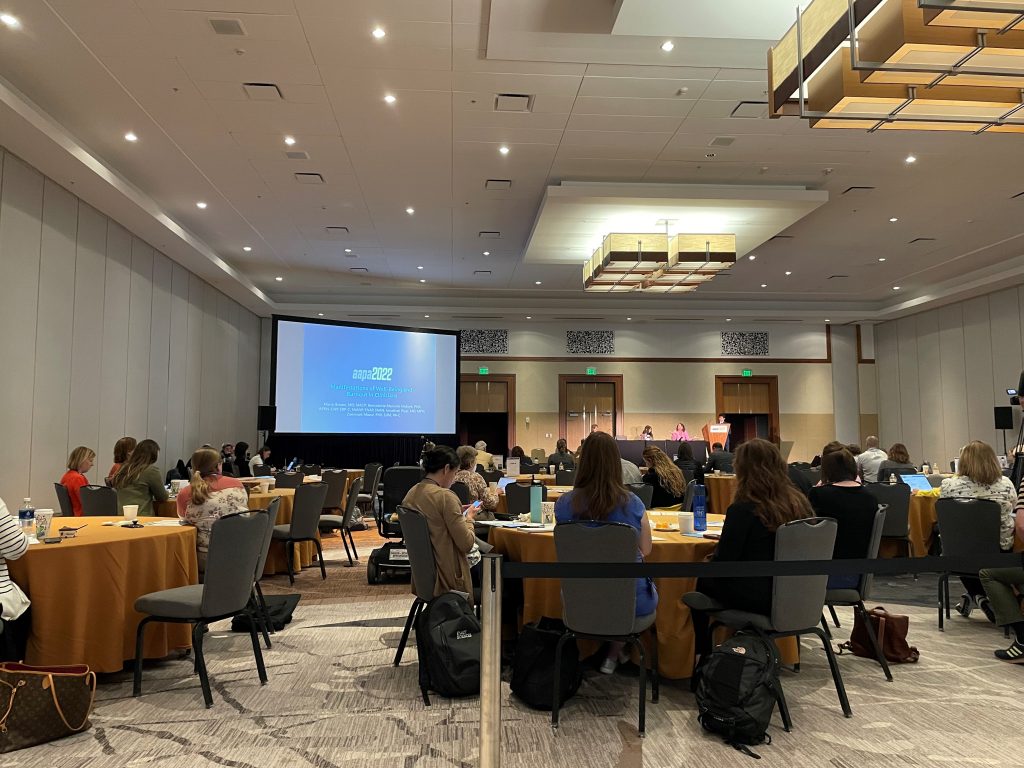Expert Insights on Barriers to Clinician Well-Being
PAs at Symposium on Clinical and Clinical Student Well-Being Share Goals and Barriers to Creating a Culture of Well-Being
July 15, 2022
AAPA Research
Understanding of PA burnout and well-being is still in the early stages, but our current healthcare environment threatens the delivery of quality care in the United States for all providers and patientsi. The COVID-19 pandemic shed light on the need to garner more resources, interventions, and research. Burnout and well-being impact providers, patients, and productivityiiiiiivvvi. It is time to start working as a team to implement a culture of wellness at every employer.

Setting the Stage
Provider well-being involves the overall physical, mental, and emotional health of individuals providing healthcare services to others, and encompasses multiple dimensions of provider distress such as depression, anxiety, stress, fatigue, and quality of life. In addition, provider well-being often includes the meaning and satisfaction providers obtain from their work.
[Support AAPA’s original research on the PA profession – join or renew today]
Symposium on Clinician and Clinical Student Well-Being
On May 23, 2022, more than 50 thought leaders across clinical professions joined AAPA 2022 attendees for a day of learning and discussing best practices to improve the well-being of clinicians throughout their careers. After a morning of learning about well-being in clinicians, clinical students, and its impact in healthcare systems, thought leaders engaged in small group discussions to talk about changes needed to create a culture of wellness at their employers, and what barriers are stopping them.
You can watch the morning sessions and earn CME by visiting AAPA’s Learning Central.
The afternoon discussion groups were broken down into three sessions: defining a culture of well-being, identifying the building blocks of change, and building a culture of well-being. The ability to be one’s authentic self, balance, and physical and psychological safety were the most common themes in defining well-being.
Barriers to Clinician Well-Being
During this session, most attendees reported three barriers to facilitating a culture of well-being in healthcare and in education.
1. Communication
Communication was the most mentioned barrier to clinician well-being. The attendees listed lack of communication, sharing, and debriefing – including lack of input in decision-making. Not sharing goals with administrators – who are already overburdened – and not collaborating with higher ups can also be understood as communication issue. Lack of communication can also be a barrier to correcting misinformation, particularly traditional thoughts and beliefs, including what constitutes benefits.
2. Workload
While work-life balance is one of the most important components of well-being according to the attendees, workload is the top barrier to facilitating it. Overbooked schedules and needing help to cover days off can be exacerbated by staffing issues. Additionally, there is a sense of obligation to the team and inability to say “no” to taking on more tasks. As one small group put it, clinicians can take the role of a “relentless caretaker.”
3. Fear
While physical and psychological safety are among the top definitions of well-being, fear is one of the biggest barriers. Clinicians fear the worst-case scenarios that may arise from disclosing that they are burned out, need mental health treatment, can’t do it all, or need to prioritize work-life balance. Worst-case scenarios include resentment, retaliation, and even the loss of a medical license. Fear of stigma is just as prominent – fear of mental stigma, fear of self-disclosure, and perceptual stigma from administrators, peers, and patients.
This article was written by Mariya Marinova, Research Project Manager, at AAPA. Contact her at [email protected].
You May Also Like
Symposium on Clinician and Clinical Student Well-Being in a Team-Based Environment (CME)
Burnout-related CME available on AAPA Learning Central
AAPA PA Burnout Resources
Reasons PAs Leave Their Jobs (JAAPA)
NAM National Plan for Health Workforce Well-Being
i National Academies of Sciences E, Medicine. Taking action against clinician burnout: a systems approach to professional well-being. 2019;
ii West CP, Dyrbye LN, Shanafelt TD. Physician burnout: contributors, consequences and solutions. Journal of internal medicine. 2018;283(6):516-529.
iii Dyrbye LN, Shanafelt TD, Sinsky CA, et al. Burnout among health care professionals: a call to explore and address this underrecognized threat to safe, high-quality care. NAM perspectives. 2017;
iv Cimiotti JP, Aiken LH, Sloane DM, Wu ES. Nurse staffing, burnout, and health care–associated infection. American journal of infection control. 2012;40(6):486-490.
v Halbesleben JR, Rathert C. Linking physician burnout and patient outcomes: exploring the dyadic relationship between physicians and patients. Health care management review. 2008;33(1):29-39.
vi Welp A, Meier LL, Manser T. The interplay between teamwork, clinicians’ emotional exhaustion, and clinician-rated patient safety: a longitudinal study. Critical Care. 2016;20(1):1-10.
Thank you for reading AAPA’s News Central
You have 2 articles left this month. Create a free account to read more stories, or become a member for more access to exclusive benefits! Already have an account? Log in.



